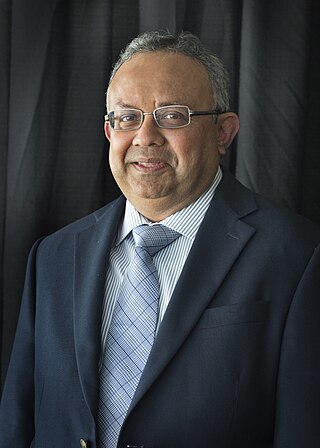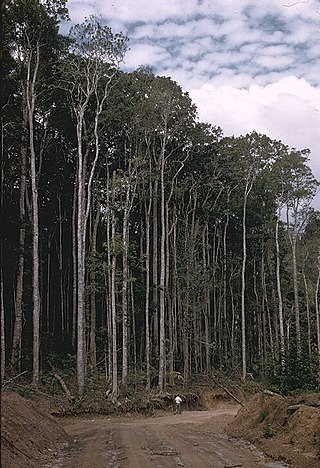Related Research Articles

A transect is a path along which one counts and records occurrences of the objects of study.
Social statistics is the use of statistical measurement systems to study human behavior in a social environment. This can be accomplished through polling a group of people, evaluating a subset of data obtained about a group of people, or by observation and statistical analysis of a set of data that relates to people and their behaviors.
The metabolic theory of ecology (MTE) is the ecological component of the more general Metabolic Scaling Theory and Kleiber's law. It posits that the metabolic rate of organisms is the fundamental biological rate that governs most observed patterns in ecology. MTE is part of a larger set of theory known as metabolic scaling theory that attempts to provide a unified theory for the importance of metabolism in driving pattern and process in biology from the level of cells all the way to the biosphere.
The Akaike information criterion (AIC) is an estimator of prediction error and thereby relative quality of statistical models for a given set of data. Given a collection of models for the data, AIC estimates the quality of each model, relative to each of the other models. Thus, AIC provides a means for model selection.

The Mongolian wild ass, also known as Mongolian khulan, is the nominate subspecies of the onager. It is found in southern Mongolia and northern China. It was previously found in eastern Kazakhstan and southern Siberia before being extirpated there through hunting. As of 2015, the Mongolian wild ass is listed as Near Threatened by the IUCN. Current population estimates are approximately 42,000 individuals in Mongolia and around 5,000 individuals in Northern China.
A Malthusian growth model, sometimes called a simple exponential growth model, is essentially exponential growth based on the idea of the function being proportional to the speed to which the function grows. The model is named after Thomas Robert Malthus, who wrote An Essay on the Principle of Population (1798), one of the earliest and most influential books on population.
Model selection is the task of selecting a model from among various candidates on the basis of performance criterion to choose the best one. In the context of machine learning and more generally statistical analysis, this may be the selection of a statistical model from a set of candidate models, given data. In the simplest cases, a pre-existing set of data is considered. However, the task can also involve the design of experiments such that the data collected is well-suited to the problem of model selection. Given candidate models of similar predictive or explanatory power, the simplest model is most likely to be the best choice.

The M51 Group is a group of galaxies located in Canes Venatici. The group is named after the brightest galaxy in the group, the Whirlpool Galaxy (M51A). Other notable members include the companion galaxy to the Whirlpool Galaxy (M51B) and the Sunflower Galaxy (M63).
The microbial food web refers to the combined trophic interactions among microbes in aquatic environments. These microbes include viruses, bacteria, algae, heterotrophic protists. In aquatic ecosystems, microbial food webs are essential because they form the basis for the cycling of nutrients and energy. These webs are vital to the stability and production of ecosystems in a variety of aquatic environments, including lakes, rivers, and oceans. By converting dissolved organic carbon (DOC) and other nutrients into biomass that larger organisms may eat, microbial food webs maintain higher trophic levels. Thus, these webs are crucial for energy flow and nutrient cycling in both freshwater and marine ecosystems.
Distance sampling is a widely used group of closely related methods for estimating the density and/or abundance of populations. The main methods are based on line transects or point transects. In this method of sampling, the data collected are the distances of the objects being surveyed from these randomly placed lines or points, and the objective is to estimate the average density of the objects within a region.
SNV calling from NGS data is any of a range of methods for identifying the existence of single nucleotide variants (SNVs) from the results of next generation sequencing (NGS) experiments. These are computational techniques, and are in contrast to special experimental methods based on known population-wide single nucleotide polymorphisms. Due to the increasing abundance of NGS data, these techniques are becoming increasingly popular for performing SNP genotyping, with a wide variety of algorithms designed for specific experimental designs and applications. In addition to the usual application domain of SNP genotyping, these techniques have been successfully adapted to identify rare SNPs within a population, as well as detecting somatic SNVs within an individual using multiple tissue samples.
Abundance estimation comprises all statistical methods for estimating the number of individuals in a population. In ecology, this may be anything from estimating the number of daisies in a field to estimating the number of blue whales in the ocean.
In ecology, plot sampling is a widely used method of abundance estimation in which specific areas, or plots, are selected from within a survey region and sampled. This approach allows scientists to make population estimates using statistical techniques such as the Horvitz–Thompson estimator. Plot sampling is generally effective when it can be assumed that each survey will identify all of the animals in the sampled area, and that the animals will be distributed uniformly and independently.

Timothy Grant Leighton is a British scientist who was a Professor of Ultrasonics and Underwater Acoustics at the University of Southampton. He is the inventor-in-chief of Sloan Water Technology Ltd., a company founded around his inventions. He is an academician of three national academies. Trained in physics and theoretical physics, he works across physical, medical, biological, social and ocean sciences, fluid dynamics and engineering. He joined the Institute of Sound and Vibration Research (ISVR) at the University of Southampton in 1992 as a lecturer in underwater acoustics, and completed the monograph The Acoustic Bubble in the same year. He was awarded a personal chair at the age of 35 and has authored over 400 publications.

Reuven Bar-On is an Israeli psychologist and one of the leading pioneers, theorists and researchers in emotional intelligence. Bar-On is thought to be the first to introduce the concept of an “EQ” to measure “emotional and social competence”, although the acronym was used earlier to describe ideas that were not associated with emotional intelligence per se. In the first copy of his doctoral dissertation, which was submitted in 1985, Bar-On proposed a quantitative approach to creating “an EQ analogous to an IQ score”.

Dipak Kumar Dey is an Indian-American statistician best known for his work on Bayesian methodologies. He is currently the Board of Trustees Distinguished Professor in the Department of Statistics at the University of Connecticut. Dey has an international reputation as a statistician as well as a data scientist. Since he earned a Ph.D. degree in statistics from Purdue University in 1980, Dey has made tremendous contributions to the development of modern statistics, especially in Bayesian analysis, decision science and model selection. Dey has published more than 10 books and edited volumes, and over 260 research articles in peer-refereed national and international journals. In addition, the statistical methodologies that he has developed has found wide applications in a plethora of interdisciplinary and applied fields, such as biometry and bioinformatics, genetics, econometrics, environmental science, and social science. Dey has supervised 40 Ph.D. students, and presented more than 200 professional talks in colloquia, seminars and conferences all over the world. During his career, Dey has been a visiting professor or scholar at many institutions or research centers around the world, such as Macquarie University, Pontificia Universidad Católica de Chile,, University of São Paulo, University of British Columbia, Statistical and Applied Mathematical Sciences Institute, etc. Dey is an elected fellow of the American Association for the Advancement of Science, the American Statistical Association, the Institute of Mathematical Statistics, the International Society for Bayesian Analysis and the International Statistical Institute.
Ruth King FRSE FLSW is the current Thomas Bayes' Chair of Statistics in the School of Mathematics at the University of Edinburgh, having held the position since 2015. Prior to this she held positions at the University of Cambridge and the University of St Andrews.

John Geoffrey Tracey was an Australian ecologist and botanist whose pioneering research work in partnership with Dr. Leonard Webb within the Rainforest Ecology Unit of the CSIRO in the 1950s led to the publication of the first systematic classification of Australian rainforest vegetation in the Journal of Ecology in 1959. By the early 80's, after decades of ongoing research, Tracey and Webb had accumulated a significant corpus of scientific evidence in support of the theory that Australian tropical rainforests had evolved in Gondwana over 100 million years ago and were not, as previously believed, relatively recent arrivals from South East Asia. This evidence, in combination with Tracey and Webb's 1975 publication of a collection of 15 vegetation maps entitled "Vegetation of the Humid Tropical Region of North Queensland", and Tracey's 1982 paper "The Vegetation of the Humid Tropical Region of North Queensland", helped to establish the scientific basis for a number of major conservation campaigns across Queensland and paved the way for the subsequent successful World Heritage nomination of the Wet Tropics of Queensland by Aila Keto in 1988.

Roderick Joseph Alexander Little is an academic statistician, whose main research contributions lie in the statistical analysis of data with missing values and the analysis of complex sample survey data. Little is Richard D. Remington Distinguished University Professor of Biostatistics in the Department of Biostatistics at the University of Michigan, where he also holds academic appointments in the Department of Statistics and the Institute for Social Research.
In the field of epidemiology, source attribution refers to a category of methods with the objective of reconstructing the transmission of an infectious disease from a specific source, such as a population, individual, or location. For example, source attribution methods may be used to trace the origin of a new pathogen that recently crossed from another host species into humans, or from one geographic region to another. It may be used to determine the common source of an outbreak of a foodborne infectious disease, such as a contaminated water supply. Finally, source attribution may be used to estimate the probability that an infection was transmitted from one specific individual to another, i.e., "who infected whom".
References
- ↑ "Poster of highlights" (PDF). Isec2018.org. Retrieved 26 July 2019.
- ↑ "Primo by Ex Libris - Buckland". Primo.abdn.ac.uk.
- ↑ "Tentsmuir National Nature Reserve". Scottish Natural Heritage.
- ↑ "BioSS:Home Page". Bioss.ac.uk.
- ↑ "CREEM - Centre for Research into Ecological & Environmental Modelling". Creem.st-anderws.ac.uk. Retrieved 26 July 2019.
- ↑ "Archived copy" (PDF). www.ncse.org.uk. Archived from the original (PDF) on 6 February 2011. Retrieved 14 January 2022.
{{cite web}}: CS1 maint: archived copy as title (link) - ↑ "National Centre for Statistical Ecology". Ncse.org.uk. Retrieved 26 July 2019.
- ↑ "School of Mathematics and Statistics - University of St Andrews". St-andrews.ac.uk. Retrieved 26 July 2019.
- ↑ "S. T. Buckland - Google Scholar Citations". Scholar.google.com. Retrieved 26 July 2019.
- ↑ "Journal of Agricultural, Biological, and Environmental Statistics - incl. option to publish open access". Springer.com. Retrieved 26 July 2019.
- ↑ "Fellows". The Royal Society of Edinburgh. 21 June 2016.
- ↑ "Announcing our honours recipients for 2019". Statslife.org.uk. Retrieved 26 July 2019.
- ↑ "Honours". Rss.org.uk. Retrieved 26 July 2019.